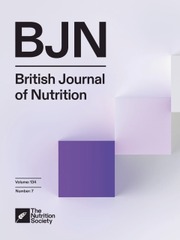No CrossRef data available.
Article contents
Comparison of BMI, triponderal mass index and paediatric body adiposity index for predicting body fat and screening obesity in preschool children
Published online by Cambridge University Press: 11 November 2024
Abstract
Several novel anthropometric indices, including paediatric body adiposity index (BAIp) and triponderal mass index (TMI), have emerged as potential tools for estimating body fat in preschool children. However, their comparative validity and accuracy, particularly when compared with established indicators such as BMI, have not been thoroughly investigated. This cross-sectional study enrolled 2869 preschoolers aged 3–6 years in Wuhan, China. The non-parametric Bland–Altman analysis was employed to evaluate the agreement between BMI, BAIp and TMI with percentage of body fat (PBF), determined by bioelectrical impedance analysis (BIA), serving as the reference measure of adiposity. Additionally, receiver operating characteristic curve analysis was conducted to assess the effectiveness of BMI, BAIp and TMI in screening for obesity. BAIp demonstrated the least bias in estimating PBF, showing discrepancies of 3·64 % (95 % CI 3·40 %, 4·12 %) in boys and 3·95 % (95 % CI 3·79 %, 4·23 %) in girls. Conversely, BMI underestimated PBF by 3·89 % (95 % CI 3·70 %, 4·37 %) in boys and 4·81 % (95 % CI 4·59 %, 5·09 %) in girls, while TMI also underestimated PBF by 5·15 % (95 % CI 4·90 %, 5·52 %) in boys and 5·68 % (95 % CI 5·30 %, 5·91 %) in girls. BAIp exhibited the highest AUC values (AUC = 0·867–0·996) in boys, whereas in girls, there was no statistically significant difference between BMI (AUC = 0·936, 95 % CI 0·921, 0·948) and BAIp (AUC = 0·901, 95 % CI 0·883, 0·916) in girls (P = 0·054). In summary, when considering the identification of obesity, BAIp shows promise as a screening tool for both boys and girls.
- Type
- Research Article
- Information
- Copyright
- © The Author(s), 2024. Published by Cambridge University Press on behalf of The Nutrition Society



